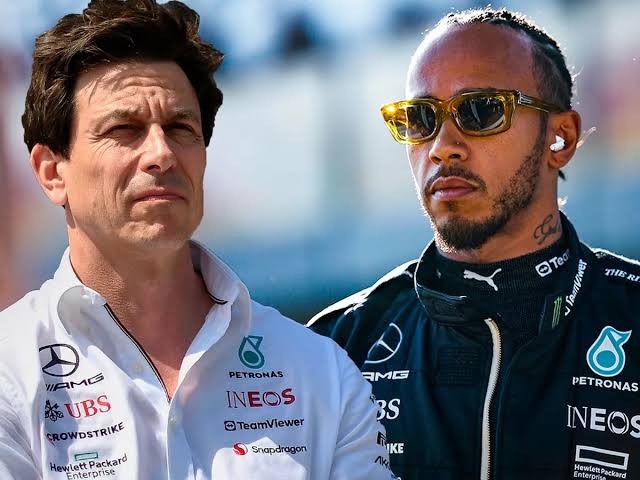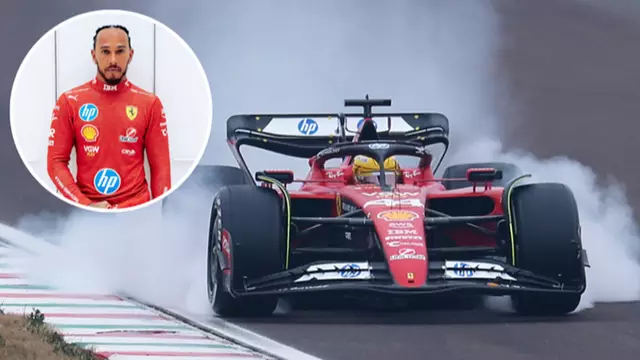The team principal of Mercedes, Toto Wolff has explained why Lewis Hamilton can’t drive for Ferrari in the post-season test in Abu Dhabi.
It is common for a driver to test for their new team in the post-season event, with outgoing Ferrari driver Carlos Sainz stepping into the Williams seat ahead of his switch next year.
It was debated whether Hamilton would be granted permission by Mercedes to test for Ferrari at the Yas Marina Circuit; however, Frederic Vasseur has not even enquired about it.
This is due to the Ferrari boss recognising that the seven-time world champion has a contract with the Silver Arrows.
When asked whether he was upset that Ferrari would not be able to run Hamilton in the test, Vasseur said: “No, no. They have a contract. They have a contract so I’ve not even asked Toto to do something.”
As revealed by Wolff, Hamilton has “contractual agreements” to respect, ruling him out of the post-season test.
Wolff explained that the 39-year-old did ask whether it would be possible to test for Ferrari in Abu Dhabi, before it was outlined to the seven-time world champion that it was off the cards.
“Fred didn’t ask. I think it’s a difference also if you’re maybe going to Williams, but we have contractual agreements with sponsors,” explained Wolff.
“We’re having a farewell for Lewis. We’re having lots of activities that are planned. And him and I, we spoke about it shortly, and he said, I guess that’s not going to work.
“I don’t think it’s going to work. And that was the whole thing. So I don’t think Fred is particularly sad.”
More News…
‘NOT MY DRIVING’ – A Message to Mercedes Amid a Difficult Goodbye

Lewis Hamilton is adamant that his own driving has not been “the issue” during the F1 2024 season with his Mercedes career ending on an unhappy note.
Hamilton announced earlier this year that he will join Ferrari on a multi-year contract from the F1 2025 season, ending his long and successful association with Mercedes.
The British driver has claimed six of his joint-record seven World Championships with Mercedes, as well as becoming the first man to surpass 100 grand prix victories and pole positions, since arriving from McLaren at the start of 2013.
Mercedes also have the distinction of providing the engines for each of Hamilton’s 355 F1 starts to date, stretching back to his debut season in 2007.
With Hamilton’s move to Ferrari confirmed in February, it has created the unusual situation of the 39-year-old spending the entirety of F1 2024 with Mercedes in the knowledge that they will part ways at the end of the season, which concludes with this weekend’s Abu Dhabi Grand Prix.
Despite returning to winning ways in F1 2024 with victories at Silverstone and Spa, Hamilton has struggled in qualifying conditions this season with Russell ahead at 18 of the 23 races.
Hamilton’s season slumped to a new low in Qatar last weekend as he incurred separate penalties for a false start and speeding in the pit lane, with the seven-time World Champion heard pleading to withdraw from the race over team radio en route to a distant 12th.
Ahead of his final race for the team, Hamilton has insisted that his own performance level has not been an issue at Mercedes in F1 2024 – and he teased that the reason for his struggles extend beyond the setup of the W15 car.
According to the BBC, he said: “Car control is not an issue and the issue is not in my driving. I don’t believe it is necessarily a setup thing.
“I only know so much.”
Andrew Shovlin, Mercedes’ trackside engineering director raised the theory that Hamilton has struggled to adjust to the ground-effect cars in place since 2022, having been restricted to just two wins across the last three seasons.
He added: “If you look for a common theme, we have a car that is difficult to turn in the slower corners.
“And the way the drivers have to turn it is by sliding the rear on the way in and sliding the rear on the power on the way out.
“That adds [tyre] temperature and dealing with that problem Lewis has found quite difficult.
“You could argue that Lewis was head and shoulders the best in the previous set of regulations. He certainly found driving the cars second nature.
“Lewis would set up the car so that, as the [rear of the] car came up [during braking] and you gained pitch, it would help you turn the car.
“He relied on those elements and that was how you generated performance in the previous set of regulations.
“He has struggled more with the way these cars run.
“These cars you need to run lower, you need to run stiffer, they are banging into the ground more, you haven’t got as much movement in the platform from low to high speed.”
Speaking to media including PlanetF1.com in Qatar, Mercedes team boss Toto Wolff suggested that Hamilton’s preferred driving style may be exacerbating his problems with the current generation of cars.
He explained: “I think one of his strengths is always how he’s able to brake late and attack the corner – and that car can’t take it.
“And then, when the grip comes in, that phenomenon is even more articulated and makes it even worse for him.
“And makes it worse for George also. And then if the car slides more and lacks grip, it comes alive.
“That’s a pattern feature of this car, so that contributes to him probably suffering more than George.”
Asked if Hamilton’s woes are related to F1’s move to ground-effect cars in 2022, Wolff pointed out that “massive oscillations” in performance have been seen across the field over the last three years.
He explained: “You can see that with this generations of car, no team has really found – apart from Red Bull, maybe the last two years, but particularly this year – the solution, that they have stable performance over most of the tracks through all of the ambient conditions.
“There are these massive oscillations that you can see. How can it be that a Red Bull is nowhere on one day and then on the next day just very dominant?
“It’s the same for us: we were two seconds quicker in Las Vegas at some time in the race, George cruised in the front and everybody else fell back.
“And then here you see the opposite. I think it’s just that it’s so sensitive to operate in that window that when you try to force it, it becomes even more unstable as a platform.
“I don’t think it’s only Lewis’s problem. We can see that in other cars with other drivers as well that have oscillating performances.
“Does [Hamilton’s driving style] add [to his woes]? Maybe.
“But this is so subtle, also driving styles, but it’s clearly when you’re very strong on the brake you need a car that’s strong on turning in and you just hit the throttle and you need lots of traction.
“When the car is not giving you any of that, it’s very difficult to drive around.”



